
How to manage Incontinence while practicing sports
It seems that practicing sports can lead to urinary leaks… and it’s TRUE. Over half of female athletes suffer from it and one in 10 female athletes may even develop organ prolapse. We explain why some women have urinary leakage issues, which sports to favor, and what solutions exist to practice sports without worries.
Help! I leak when I exercise
Physical activity puts pressure on the pelvic floor. Urinary leaks can occur if it does not contract strongly and/or quickly enough.

Impact of sports and physical activity on the pelvic floor
It is important to remember that the pelvic floor is engaged daily in its functions of continence and supporting the pelvic organs. Imagine it as a three-dimensional structure that adapts to our movements and breathing.
Depending on the sport practiced, the pelvic floor is more or less engaged. In “non-impact” sports such as cycling, swimming, or rollerblading, the impact on the pelvic floor is relatively low. Impact sports like running or trampolining put more strain on the pelvic floor. Problems can arise in the long term.
Urinary leaks and pelvic floor
To prevent involuntary urine leakage, the closing pressure of the sphincter must be greater than the pressure exerted by the urine to exit.

During intense abdominal contractions, the belly puts pressure on the bladder and the sphincter cannot retain urine. While running, urinary leaks do not occur immediately. Indeed, the pelvic floor gradually deteriorates with this type of sport. The sphincter muscles become less effective and tire out.
It is interesting to note that urinary leaks affect 52% of female athletes. A study from 2002 even indicates that 11% of female athletes experience organ prolapse during their lifetime.
Sport and prolapse
Indeed, the pelvic floor supports the bladder, uterus, or rectum. With repeated impacts, these suspensory muscles and ligaments can stretch, can cause urine leaks during exercise and furthermore, inadequate support for these organs could cause them to descend into the vagina. This is what is called organ prolapse or simply a prolapse. Impact sports therefore increase the risk of developing organ prolapse.
The best way to avoid these problems is through prevention! Regularly do exercises to maintain a strong perineum and reduce the risks of developing urinary leaks or prolapse during sports.
Protecting your pelvic floor during sports practice
Many solutions exist. You can discuss alternatives directly with a health professional. Several factors will need to be taken into account to offer you an appropriate solution to prevent urinary leaks during exercise:
- Type of exercise or sport
- Intensity Level
- Frequency of Urinary leaks during exercise
Which type sports to choose in case of urinary leaks?
After childbirth or in case of urinary leaks during intense physical activity, it is recommended to choose sports/exercises that support the pelvic floor . Cycling, swimming, or Pilates involve few jumps. Incontinence during exercise is a widespread problem.
They therefore exert little pressure on the pelvic muscles. Once you have better control over your pelvic floor, you can consider team sports such as tennis, running, Zumba.
Sports to favor for protecting your pelvic floor
Here are some sports that don’t heavily impact your pelvic floor
- Swimming
- Cycling
- Pilates
- Walking

Sports at risk for the pelvic floor
These would like exacerbate urine leaks during exercise-
- Running
- Jump-rope
- basketball
- football
- handball
- tennis
- horse back riding
Adapting your sports practice
Initially, it is possible to adapt your sports practice and limit strong impacts on the ground. Sports like trampolining are more at risk of developing urinary incontinence.
It’s not so much the sport itself but the repeated impacts on the ground at high speed like jumping that are linked to urinary leaks during exercise.
Therefore, if you experience incontinence suring exercise, you can vary your sport to reduce impacts. You can also adjust your movement pattern to lessen the impact during your practice.
Taking care of your pelvic floor during sports
Maintaining proper hydration
If you experience urine leaks during sports, you may think that reducing the amount of water you drink before and during it would reduce leaks.

Your body needs to be sufficiently hydrated during your sports practice. Therefore, maintain good hydration during your activities.
Do not urinate as a precaution
You would think that you wouldn’t leak on an empty bladder
Although this is still advised by some health professionals, urinating without the need to urinate alters the
Therefore, urinating as a precaution should be used sparingly. The best practice is to talk to a health professional about it. In fact, only 4.5% of female athletes experiencing urinary leaks talk about it!

Wearing a pessary during sports practice
A temporary solution to use during sports can be the pessary. It is an intravaginal device in the form of a disc or ring that holds the pelvic organs in place.
Easy to insert, this solution is simple to implement and helps temporarily avoid involuntary incontinence during exercise.
Wearing a pessary does not address the root cause of urinary leaks during exercise. It simply relieves symptoms.
Train your pelvic floor
Regularly train and strengthen your pelvic floor to avoid urinary leaks druing exercise.
Strengthening the pelvic floor through rehabilitation
Your healthcare professional may also prescribe exercises tailored to your pelvic floor that can be practiced at home.
Generally, pelvic floor rehabilitation allows you to become aware of your pelvic floor and tone it. It can be done at a rehabilitation center or at home.
Strengthening your pelvic floor at home with the Emy solution
Looking for a practical solution to strengthen your pelvic floor and stay dry? The Emy smart kegel trainer allows you to train your pelvic floor wherever and whenever you want!
Emy is connected to a fun app that allows you to visualize your pelvic contractions in real time on your smartphone.
The Emy trainer is based on Kegel exercises. It helps work all pelvic floor muscles actively through biofeedback.
Various programs are available and exercises adapt to each woman’s level. An effective solution to strengthen the pelvic floor and exercise with peace of mind, without worrying about incontinence during exercise!
Tailored sports programs for the pelvic floor
Emy app designs a personalised exercise program for your pelvic floor.

These sessions allow targeted work for:
- Repetition
- Endurance
- Rapidity
The Emy app offers more than 14 programs created by specialized coaches, and the sessions are suitable for all levels.
Thus, these programs will allow you to regain complete control of your body while taking care of your pelvic floor!

Free Pelvic floor guide
Find out how to strengthen your pelvic floor to prevent bladder weakness and improve intimate pleasure! 💥




